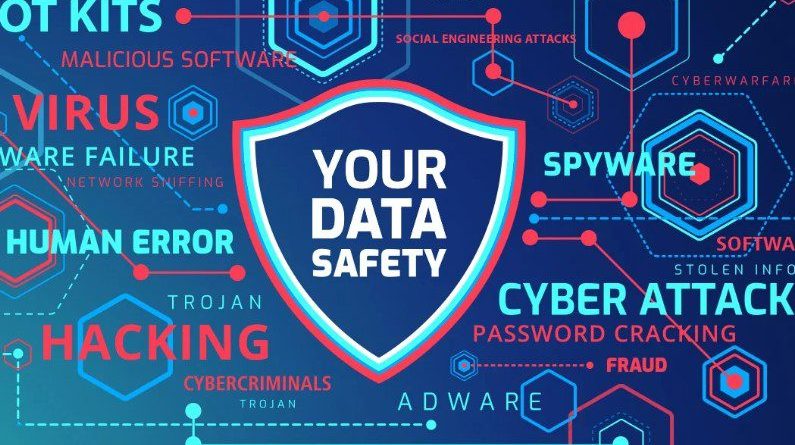Cybersecurity Threats in 2025: What You Must Know
The most dangerous cybersecurity threats in 2025 which include AI-powered phishing, ransomware-as-a-service, quantum computing risks, and nation-state attacks.
What is CyberSecurity?, a question for all and the modern age. Cybersecurity is the act or practice in which is used to protect computer network, systems and data from digital damages, threats and theft, you might be wondering who might want to steal you computer information, it can come from anywhere and that is where the Cyber and security came from using ranges of technologies, codings to stop all threats.
Cybersecurity landscape in 2025 presents unprecedented challenges that demand immediate attention and strategic response. As digital transformation accelerates globally, cybercriminals are leveraging artificial intelligence, automation, and sophisticated techniques to exploit vulnerabilities at scale. The threats facing organizations and individuals today are more complex, persistent, and damaging than ever before.
Understanding these emerging threats and implementing comprehensive defense strategies is no longer optional—it’s essential for survival in an increasingly connected world. From AI-generated phishing campaigns to quantum computing threats, the cybersecurity challenges of 2025 require a fundamental shift in how we approach digital security.
This comprehensive analysis examines the most critical cybersecurity threats of 2025 and provides actionable guidance for protecting against these evolving dangers. Whether you’re a business leader, IT professional, or individual user, understanding these threats and implementing appropriate defenses is crucial for maintaining security in the digital age.
AI-Powered Phishing and Advanced Social Engineering
The Evolution of Phishing Attacks
Artificial intelligence has revolutionized the phishing landscape, enabling cybercriminals to create highly convincing and personalized attacks that are increasingly difficult to detect. AI-generated emails, SMS messages, and voice communications are becoming indistinguishable from legitimate communications, making traditional security awareness training less effective.
Modern AI-powered phishing campaigns utilize natural language processing to create contextually relevant messages that incorporate personal information gathered from social media, public records, and previous data breaches. These campaigns can automatically generate thousands of unique, personalized messages that adapt to individual targets’ communication styles and interests.
The sophistication of these attacks extends beyond text-based communications. Cybersecurity professionals report that AI-generated voice and video deepfakes are being used to impersonate trusted contacts, executives, and even family members to manipulate victims into revealing sensitive information or transferring funds.
Deepfake Technology in Cybercrime
Deepfake technology has emerged as one of the most concerning developments in cybercrime, enabling the creation of realistic audio and video content that can be used for sophisticated social engineering attacks. These AI-generated media files can impersonate anyone, making it possible for criminals to conduct convincing video calls or leave authentic-sounding voicemails.
The Federal Bureau of Investigation has documented numerous cases where deepfake technology was used to facilitate business email compromise attacks, with criminals impersonating executives to authorize fraudulent wire transfers. These attacks are particularly effective because they exploit the trust and authority relationships within organizations.
The democratization of deepfake technology through easily accessible applications and services has made these attacks more common and accessible to less technically skilled criminals. This trend is expected to continue as the technology becomes more sophisticated and user-friendly.

Defense Strategies Against AI-Powered Attacks
Protecting against AI-powered phishing and deepfake attacks requires a multi-layered approach that combines technology, processes, and human awareness. Organizations must implement advanced email security solutions that use machine learning to detect AI-generated content and unusual communication patterns.
Verification protocols become critical in the age of deepfakes. Organizations should establish procedures for verifying the identity of individuals making requests for sensitive information or financial transactions, particularly when these requests are made through digital channels.
Employee training programs must evolve to address the new realities of AI-powered attacks. Traditional phishing awareness training that focuses on obvious red flags is less effective against sophisticated AI-generated content. Instead, training should emphasize verification procedures, healthy skepticism, and the importance of out-of-band verification for sensitive requests.
Automated Cyber Scanning and Vulnerability Exploitation
The Scale of Automated Attacks
The cybersecurity threat landscape has been transformed by the unprecedented scale of automated attacks. According to Fortinet’s Global Threat Landscape Report, automated vulnerability scans have reached 36,000 attempts per second, representing a massive increase in the volume and frequency of attack attempts.
These automated systems continuously scan the internet for vulnerable systems, outdated software, and misconfigured services. The speed and scale of these operations mean that newly discovered vulnerabilities can be exploited within hours or even minutes of their disclosure, leaving organizations little time to implement patches and protective measures.
The targets of these automated attacks are diverse, ranging from enterprise networks and cloud infrastructure to Internet of Things (IoT) devices and personal computers. Remote Desktop Protocol (RDP) services, web applications, and network-attached storage devices are particularly common targets for automated exploitation attempts.
Targeting of Legacy Systems and IoT Devices
Legacy systems and IoT devices represent attractive targets for automated attacks due to their often poor security posture and infrequent updates. Many organizations continue to operate older systems that lack modern security features and may not receive regular security updates, making them vulnerable to both new and well-known attack techniques.
The proliferation of IoT devices in both consumer and enterprise environments has created a massive attack surface that is difficult to manage and secure. Many IoT devices are deployed with default credentials, weak encryption, and limited security features, making them easy targets for automated exploitation.
The Nigeria’s cybersecurity landscape demonstrates how these automated attacks can affect developing markets, where organizations may have limited resources for maintaining and securing their technology infrastructure.
Defensive Measures Against Automated Attacks
Protecting against automated attacks requires a comprehensive approach that addresses both prevention and detection. Organizations must maintain current inventories of all systems and devices connected to their networks, ensuring that security patches are applied promptly and that unnecessary services are disabled.
Network segmentation and access controls are essential for limiting the impact of successful automated attacks. By isolating critical systems and implementing strict access controls, organizations can prevent attackers from moving laterally through their networks even if initial access is gained.
Continuous monitoring and threat detection systems help identify and respond to automated attacks in real-time. These systems use behavioral analysis and machine learning to detect unusual network activity and potential attack patterns, enabling rapid response to emerging threats.
Ransomware-as-a-Service and Advanced Persistent Threats
The Commercialization of Ransomware
The ransomware threat landscape has evolved significantly with the emergence of Ransomware-as-a-Service (RaaS) platforms that enable even novice criminals to launch sophisticated attacks. These platforms provide ready-made ransomware tools, infrastructure, and support services, dramatically lowering the barrier to entry for ransomware operations.
RaaS platforms operate on subscription models, with providers offering various service tiers that include different levels of support, customization, and revenue sharing arrangements. This business model has led to the professionalization of ransomware operations and the development of specialized roles within cybercriminal organizations.
The impact of RaaS extends beyond individual attacks to create a thriving ecosystem of cybercriminal services. This includes money laundering services, negotiation specialists, and technical support teams that help maximize the success and profitability of ransomware operations.
Living-Off-The-Land Techniques
Modern ransomware groups increasingly employ “living-off-the-land” techniques that use legitimate system tools and processes to conduct malicious activities. These techniques are particularly effective because they blend in with normal system operations, making detection more difficult for traditional security tools.
Common living-off-the-land techniques include using PowerShell scripts for system reconnaissance, Windows Management Instrumentation (WMI) for lateral movement, and legitimate administrative tools for data exfiltration. These methods help attackers maintain persistence while avoiding detection by security systems that focus on identifying known malicious software.
The use of legitimate tools also complicates incident response efforts, as security teams must distinguish between legitimate administrative activities and malicious use of the same tools. This challenge requires sophisticated behavioral analysis and threat hunting capabilities.
Ransomware Prevention and Response
Effective ransomware prevention requires a comprehensive approach that addresses the entire attack lifecycle. Organizations must implement robust backup and recovery procedures, maintain network segmentation, and deploy advanced endpoint detection and response (EDR) solutions.
Application allowlisting has emerged as a particularly effective defense against ransomware attacks. By restricting the execution of unauthorized applications, organizations can prevent many ransomware variants from running, even if they successfully infiltrate the network.
Incident response planning specifically for ransomware attacks is crucial for minimizing damage and ensuring rapid recovery. These plans should include procedures for isolating affected systems, communicating with stakeholders, and determining whether to engage with attackers or restore from backups.
Shadow AI and Unauthorized Technology Use
The Rise of Shadow AI
The proliferation of artificial intelligence tools and services has created a new category of security risk known as “shadow AI.” This refers to the unauthorized use of AI tools and services by employees without proper oversight or security controls, potentially exposing organizations to data breaches, compliance violations, and other security risks.
Shadow AI encompasses a wide range of tools and services, from consumer-grade chatbots and image generators to sophisticated business intelligence platforms. Employees often use these tools to improve productivity or solve business problems, but without proper governance, they can create significant security vulnerabilities.
The challenge of shadow AI is compounded by the rapid pace of AI development and the ease with which new tools can be accessed and deployed. Organizations often lack visibility into what AI tools their employees are using and how sensitive data is being processed through these systems.
Supply Chain and Third-Party Risks
The integration of AI tools into business processes creates new supply chain risks that organizations must carefully manage. Many AI services are provided by third-party vendors with varying levels of security maturity and data protection practices, potentially exposing organizations to indirect security risks.
Data sovereignty and privacy concerns are particularly relevant when using cloud-based AI services, as sensitive information may be processed in different jurisdictions with varying legal protections. Organizations must carefully evaluate the data handling practices of AI service providers and ensure compliance with applicable regulations.
The dependency on third-party AI services also creates potential single points of failure that could disrupt business operations. Organizations should develop contingency plans for scenarios where critical AI services become unavailable or compromised.
Governance and Risk Management
Effective governance of AI use requires comprehensive policies and procedures that address both authorized and unauthorized use of AI tools. Organizations should establish clear guidelines for AI tool selection, data handling, and risk assessment procedures.
Risk assessment frameworks specifically designed for AI tools help organizations evaluate the potential security and privacy implications of different AI services. These frameworks should consider factors such as data sensitivity, processing location, vendor security practices, and compliance requirements.
Regular audits and monitoring of AI tool usage help organizations maintain visibility into their AI risk exposure and ensure compliance with established policies. These audits should include both technical assessments and reviews of business processes that incorporate AI tools.
Post-Quantum Cryptography and Future Threats
The Quantum Computing Threat
The development of quantum computing technology poses a fundamental threat to current cryptographic systems that protect digital communications and data. While practical quantum computers capable of breaking current encryption methods are not yet widely available, the timeline for their development is accelerating, with experts predicting significant capabilities within the next 12-18 months.
The threat posed by quantum computing is not limited to future attacks; it also includes the risk of “harvest now, decrypt later” attacks where adversaries collect encrypted data today with the intention of decrypting it once quantum computers become available. This threat model requires organizations to begin protecting sensitive data now, even if quantum attacks are not yet feasible.
The National Institute of Standards and Technology has been working to develop post-quantum cryptographic standards that will be resistant to quantum attacks. These standards represent a fundamental shift in cryptographic approaches and will require significant updates to existing systems and protocols.
Transition Challenges and Timeline
The transition to post-quantum cryptography presents significant technical and operational challenges for organizations. Existing cryptographic implementations must be identified, assessed, and replaced with quantum-resistant alternatives, a process that can be complex and time-consuming.
Compatibility issues between new post-quantum algorithms and existing systems create additional challenges for organizations planning their transitions. Many legacy systems may not be capable of supporting new cryptographic methods without significant modifications or replacements.
The timeline for post-quantum cryptography adoption is being driven by both technical developments and regulatory requirements. Organizations must balance the need to protect against future quantum threats with the practical challenges of implementing new cryptographic systems.
Implementation Strategies
Successful implementation of post-quantum cryptography requires comprehensive planning and a phased approach. Organizations should begin by conducting inventories of their current cryptographic implementations and assessing the priority for replacement based on data sensitivity and exposure risk.
Hybrid approaches that combine traditional and post-quantum cryptographic methods can provide protection during the transition period while maintaining compatibility with existing systems. These hybrid solutions offer defense against both classical and quantum attacks.
Organizations should also consider the performance implications of post-quantum cryptographic algorithms, as many require additional computational resources and may impact system performance. Proper capacity planning and performance testing are essential for successful implementation.
Nation-State Attacks and Advanced Persistent Threats
The Geopolitical Cybersecurity Landscape
Nation-state actors continue to pose significant threats to both public and private sector organizations worldwide. These sophisticated adversaries have access to substantial resources, advanced tools, and skilled personnel, enabling them to conduct long-term campaigns that can remain undetected for months or years.
The motivations behind nation-state attacks vary widely, including espionage, economic advantage, political influence, and disruption of critical infrastructure. These attacks often target high-value assets such as government agencies, defense contractors, financial institutions, and critical infrastructure providers.
The Cybersecurity and Infrastructure Security Agency regularly publishes threat intelligence reports highlighting the tactics, techniques, and procedures used by various nation-state actors, helping organizations understand and defend against these advanced threats.
Attribution and Response Challenges
Attribution of nation-state attacks remains one of the most challenging aspects of cybersecurity. Advanced persistent threat groups often use sophisticated techniques to obscure their origins, including the use of compromised infrastructure, false flag operations, and third-party proxies.
The complex nature of nation-state attacks makes incident response and recovery particularly challenging. These attacks often involve multiple attack vectors, long-term persistence, and sophisticated evasion techniques that can complicate detection and remediation efforts.
International cooperation and information sharing are essential for effectively addressing nation-state threats. Organizations should participate in threat intelligence sharing programs and maintain relationships with law enforcement and government agencies to stay informed about emerging threats.
Defensive Strategies Against Nation-State Threats
Defending against nation-state attacks requires a comprehensive security program that addresses all aspects of the attack lifecycle. Organizations should implement zero-trust security models that assume no user or device can be trusted without verification.
Advanced threat detection and response capabilities are essential for identifying and responding to nation-state attacks. These capabilities should include behavioral analysis, threat hunting, and the ability to detect and respond to advanced persistent threat techniques.
Regular security assessments and penetration testing help organizations identify vulnerabilities that could be exploited by nation-state actors. These assessments should be conducted by qualified security professionals who understand the tactics and techniques used by advanced threat actors.
Conclusion and Future Outlook
The cybersecurity threats of 2025 represent a significant evolution in the complexity and sophistication of attacks facing organizations and individuals. The integration of artificial intelligence, automation, and advanced techniques by cybercriminals has created new challenges that require innovative defense strategies and comprehensive security programs.
Organizations must adopt a proactive approach to cybersecurity that addresses the full spectrum of threats, from AI-powered phishing and automated attacks to nation-state campaigns and quantum computing risks. This requires investment in advanced security technologies, skilled personnel, and comprehensive security programs that can adapt to evolving threats.
The importance of cyber insurance as a risk management tool continues to grow as organizations face increasingly sophisticated and costly cyber attacks. However, insurance should be viewed as part of a comprehensive risk management strategy rather than a substitute for proper security controls.
Looking ahead, the cybersecurity landscape will continue to evolve rapidly as new technologies emerge and threat actors adapt their techniques. Organizations must remain vigilant, continuously update their security programs, and invest in the people and technologies needed to defend against these evolving threats.
The key to success in 2025 and beyond is building comprehensive cyber resilience that enables organizations to prevent, detect, respond to, and recover from cyber attacks. This requires a holistic approach that addresses technology, processes, and people while maintaining the flexibility to adapt to new and emerging threats.
By understanding the threats outlined in this analysis and implementing appropriate defense strategies, organizations can better protect themselves against the cybersecurity challenges of 2025 and beyond. The investment in cybersecurity today will determine an organization’s ability to thrive in an increasingly connected and digital world.



